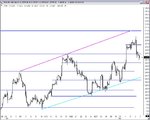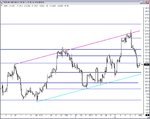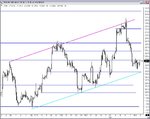Chart 1: By 2:00 a.m., price is pressing up against R at 1.2183.
T1: I've adjusted the S/R level to 1.2177 to reflect my interpretation of price action. (Where did price RET to after the BO?) Entry is at 1.2183 with initial stop at 1.2175. Targets are:
C1 - 1.2191 (8 pips)
C2 - 1.2121 (38 pips)
Result is (-8, -8, -8)
T2: I'm trying again at this level (1.2177). Entry is 1.2179, with initial stop at 1.2174. After being SO by 1 pip last time, I'm a bit wary of this entry. Targets are:
C1 - 1.2184 (4 pips)
C2 - 1.2121 (42 pips)
Result is (4, -2, -2)
Chart 4: A couple of thoughts. First, T2 entry was a bit early. The rules would have kept me from entering until a few minutes later, although the results would have been the same.
Second, with T2, I didn't notice that price was moving within a range from about 1.2176 to 1.2193. The target for C2 should have been 1.2193.
Third, had I just left the S/R level at 1.2183, I would have just received a signal to go short.
What my rules say about this situation is that I should acknowledge the range that has developed, and that trade direction rules are the same as usual. That means, with the exception of not setting the C2 target correctly, I've been following my rules. So at this point, I'm not in a trade, and I'm waiting for a valid entry signal.
T3: Buyers have pushed price back into the range that developed previously. My entry is 1.2178, with an initial stop of 1.2173. Targets are:
C1 - 1.2183 (5 pips)
C2 - 1.2193 (15 pips)
Result is (5, -3, -3)
T4: Same rationale as T3. Entry is 1.2179 with stop at 1.2174. Targets are:
C1: 1.2184 (5 pips)
C2: 1.2193 (14 pips)
Result is (5, -4, -4)
(I forgot to capture the image at the T4 entry).



















